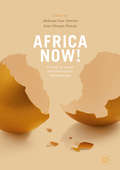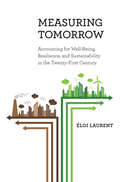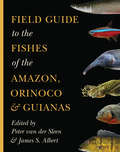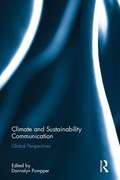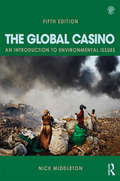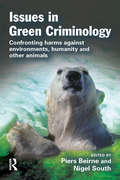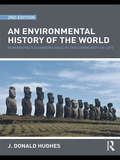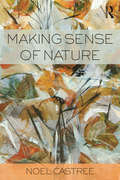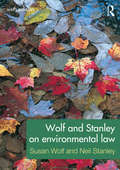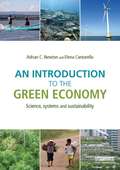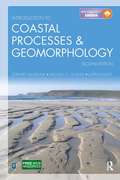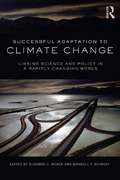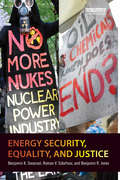- Table View
- List View
Africa Now!: Emerging Issues and Alternative Perspectives
by Adebusuyi Adeniran Lanre IkuteyijoThis book presents relevant and timely endogenous procedures for addressing the challenge of transforming ideas into sustainable opportunities in Africa. It explores how Africa could be understood in the context of emerging global realities, providing alternative frameworks that will not just be participatory in conception and practice, but equally show a contextual workability for the varying aspects of the developmental enterprise in Africa. Despite having alternative and less cumbersome sources of funding, with commendable economic growth indices, and several economies among the fastest growing globally, African countries have been unable to transmute related opportunities into sustainable human development outcomes for majority of its citizenry. Over four rich sections the authors cover subjects ranging from environment and natural resource management, to governance, economy and sustainable development. The book continues with a section on Education and Human Development and a case study in transnationalism. The final section discusses crime, conflict and regional dynamics, including highly disputed topics such as forced migration and sex trade.This indispensable resource will be of great use to students and researches globally in fields such as sociology, anthropology, environmental studies, politics and economics with a focus on contemporary Africa, as well as to policy planners and human rights activists invested in the future development of Africa.
Measuring Tomorrow: Accounting for Well-Being, Resilience, and Sustainability in the Twenty-First Century
by Éloi LaurentHow moving beyond GDP will improve well-being and sustainabilityNever before in human history have we produced so much data, and this empirical revolution has shaped economic research and policy profoundly. But are we measuring, and thus managing, the right things—those that will help us solve the real social, economic, political, and environmental challenges of the twenty-first century? In Measuring Tomorrow, Éloi Laurent argues that we need to move away from narrowly useful metrics such as gross domestic product and instead use broader ones that aim at well-being, resilience, and sustainability. By doing so, countries will be able to shift their focus away from infinite and unrealistic growth and toward social justice and quality of life for their citizens.The time has come for these broader metrics to become more than just descriptive, Laurent argues; applied carefully by private and public decision makers, they can foster genuine progress. He begins by taking stock of the booming field of well-being and sustainability indicators, and explains the insights that the best of these can offer. He then shows how these indicators can be used to develop new policies, from the local to the global.An essential resource for scholars, students, and policymakers, Measuring Tomorrow covers all aspects of well-being—including health, education, and the environment—and incorporates a broad range of data and fascinating case studies from around the world: not just the United States and Europe but also China, Africa, the Middle East, and India.
Measuring Tomorrow: Accounting for Well-Being, Resilience, and Sustainability in the Twenty-First Century
by Éloi LaurentHow moving beyond GDP will improve well-being and sustainabilityNever before in human history have we produced so much data, and this empirical revolution has shaped economic research and policy profoundly. But are we measuring, and thus managing, the right things—those that will help us solve the real social, economic, political, and environmental challenges of the twenty-first century? In Measuring Tomorrow, Éloi Laurent argues that we need to move away from narrowly useful metrics such as gross domestic product and instead use broader ones that aim at well-being, resilience, and sustainability. By doing so, countries will be able to shift their focus away from infinite and unrealistic growth and toward social justice and quality of life for their citizens.The time has come for these broader metrics to become more than just descriptive, Laurent argues; applied carefully by private and public decision makers, they can foster genuine progress. He begins by taking stock of the booming field of well-being and sustainability indicators, and explains the insights that the best of these can offer. He then shows how these indicators can be used to develop new policies, from the local to the global.An essential resource for scholars, students, and policymakers, Measuring Tomorrow covers all aspects of well-being—including health, education, and the environment—and incorporates a broad range of data and fascinating case studies from around the world: not just the United States and Europe but also China, Africa, the Middle East, and India.
Field Guide to the Fishes of the Amazon, Orinoco, and Guianas
by Peter van der Sleen James S. AlbertThe Amazon and Orinoco basins in northern South America are home to the highest concentration of freshwater fish species on earth, with more than 3,000 species allotted to 564 genera. Amazonian fishes include piranhas, electric eels, freshwater stingrays, a myriad of beautiful small-bodied tetras and catfishes, and the largest scaled freshwater fish in the world, the pirarucu. Field Guide to the Fishes of the Amazon, Orinoco, and Guianas provides descriptions and identification keys for all the known genera of fishes that inhabit Greater Amazonia, a vast and still mostly remote region of tropical rainforests, seasonally flooded savannas, and meandering lowland rivers.The guide’s contributors include more than fifty expert scientists. They summarize the current state of knowledge on the taxonomy, species richness, and ecology of these fish groups, and provide references to relevant literature for species-level identifications. This richly illustrated guide contains 700 detailed drawings, 190 color photos, and 500 distribution maps, which cover all genera. An extensive and illustrated glossary helps readers with the identification keys.The first complete overview of the fish diversity in the Amazon, Orinoco, and Guianas, this comprehensive guide is essential for anyone interested in the freshwater life inhabiting this part of the world.First complete overview of the fish diversity in the Amazon and Orinoco basinsContributors include more than fifty expertsIdentification keys and distribution maps for all genera190 stunning color photos 700 detailed line drawingsExtensive and illustrated glossary
Field Guide to the Fishes of the Amazon, Orinoco, and Guianas
by Peter van der Sleen James S. AlbertThe Amazon and Orinoco basins in northern South America are home to the highest concentration of freshwater fish species on earth, with more than 3,000 species allotted to 564 genera. Amazonian fishes include piranhas, electric eels, freshwater stingrays, a myriad of beautiful small-bodied tetras and catfishes, and the largest scaled freshwater fish in the world, the pirarucu. Field Guide to the Fishes of the Amazon, Orinoco, and Guianas provides descriptions and identification keys for all the known genera of fishes that inhabit Greater Amazonia, a vast and still mostly remote region of tropical rainforests, seasonally flooded savannas, and meandering lowland rivers.The guide’s contributors include more than fifty expert scientists. They summarize the current state of knowledge on the taxonomy, species richness, and ecology of these fish groups, and provide references to relevant literature for species-level identifications. This richly illustrated guide contains 700 detailed drawings, 190 color photos, and 500 distribution maps, which cover all genera. An extensive and illustrated glossary helps readers with the identification keys.The first complete overview of the fish diversity in the Amazon, Orinoco, and Guianas, this comprehensive guide is essential for anyone interested in the freshwater life inhabiting this part of the world.First complete overview of the fish diversity in the Amazon and Orinoco basinsContributors include more than fifty expertsIdentification keys and distribution maps for all genera190 stunning color photos 700 detailed line drawingsExtensive and illustrated glossary
Climate And Sustainability Communication: Global Perspectives (PDF)
by Donnalyn PompperClimate and Sustainability Communication: Global Perspectives builds upon traditional approaches to understanding the role of mass media in shaping social issues by amplifying diverse perspectives of opinion leaders, as well as voices of those affected by climate and sustainability issues. From South Korea and China, to the United States and Zambia, the studies reported in this book#65533;compiled using a variety of formal research methods, including content analysis, interview, and survey#65533;emphasize cultural orientation and global implications of climate and sustainability concerns and issues. The contributors explore the cultures, geographies, and media systems underpinning climate and sustainability campaigns emerging around the world, how we theorize about them, and the ways in which media are used to communicate about them. The way in which complex problems and opportunities associated with globalization and power inequities interplay with climate and sustainability communication requires creative, interdisciplinary, approaches. This book opens new conversations for integrating scholarly arenas of mass media communication, science and environmental communication, political communication, and health communication, as well as their respective theory and research method sets. This book was originally published as a special issue of Mass Communication and Society.
The Global Casino
by Nick MiddletonThe Global Casino is an introduction to environmental issues which deals both with the workings of the physical environment and the political, economic and social frameworks in which the issues occur. Using examples from all over the world, the book highlights the underlying causes behind environmental problems, the human actions which have made them issues, and the hopes for solutions. It is a book about the human impact on the environment and the ways in which the natural environment impacts human society. The fifth edition has been fully revised and updated throughout, with new case studies, figures, and online resources such as downloadable figures and tables from the text and multiple choice questions for students, accessible at: www. routledge. com/cw/middleton. New topics covered in extended boxed case studies include payment for environmental services, ocean acidification, biofuels in Brazil, waste reduction through industrial symbiosis, and the long-term impact of natural disasters on vulnerable groups. Other approaches and concepts covered for the first time in this new edition include traditional ecological knowledge, environmental justice, the resource curse, and urban biodiversity. Eighteen chapters on key issues follow three initial chapters which outline the background contexts of the physical and human environments and the concept of sustainable development. Each chapter provides historical context for key issues, outlines why they have arisen, and highlights areas of controversy and uncertainty to appraise how issues can be resolved both technically and in political and economic frameworks. Each chapter also contains an updated critical guide to further reading and websites, as well as discussion points and essay questions. The text can be read in its entirety or individual chapters adopted as standalone reading. The Global Casino is an essential resource for students of the environment, geography, earth sciences and development studies. It provides comprehensive and inspirational coverage of all the major global environmental issues of the day in a style that is clear and critical. "
Issues in Green Criminology
by Piers Beirne Nigel SouthIssues in Green Criminology: confronting harms against environments, humanity and other animals aims to provide, if not a manifesto, then at least a significant resource for thinking about green criminology, a rapidly developing field. It offers a set of specially written introductions and a variety of current and new directions, wide-ranging in scope and international in terms of coverage and contributors. It provides focused discussions of current and cutting edge issues that will influence the emergence of a coherent perspective on green issues. The contributors are drawn from the leading thinkers in the field. The twelve chapters of the book explore the myriad ways in which governments, transnational corporations, military apparatuses and ordinary people going about their everyday lives routinely harm environments, other animals and humanity. The book will be essential reading not only for students taking courses in colleges and universities but also for activists in the environmental and animal rights movements. Its concern is with an ever-expanding agenda − the whys, the hows and the whens of the generation and control of the many aspects of harm to environments, ecological systems and all species of animals, including humans. These harms include, but are not limited to, exploitation, modes of discrimination and disempowerment, degradation, abuse, exclusion, pain, injury, loss and suffering. Straddling and intersecting these many forms of harm are key concepts for a green criminology such as gender inequalities, racism, dominionism and speciesism, classism, the north/south divide, the accountability of science, and the ethics of global capitalist expansion. Green criminology has the potential to provide not only a different way of examining and making sense of various forms of crime and control responses (some well known, others less so) but can also make explicable much wider connections that are not generally well understood. As all societies face up to the need to confront harms against environments, other animals and humanity, criminology will have a major role to play. This book will be an essential part of this process.
An Environmental History of the World: Humankind's Changing Role in the Community of Life
by J. Donald HughesThis second edition of An Environmental History of the World continues to present a concise history, from ancient to modern times, of the interactions between human societies and the natural environment, including the other forms of life that inhabit our planet. Throughout their evolutionary history, humans have affected the natural environment, sometimes with a promise of sustainable balance, but also in a destructive manner. This book investigates the ways in which environmental changes, often the result of human actions, have caused historical trends in human societies. This process has happened in every historical period and in every part of the inhabited earth. The book is organized into ten chapters. The main chapters follow a chronological path through the history of mankind, in relationship to ecosystems around the world. The first explains what environmental history is, and argues for its importance in understanding the present state of the world's ecological problems. Chapters two through eight form the core of the historical analysis, each concentrating on a major period of human history (pre-civilized, early civilizations, classical, medieval, early modern, early and later twentieth century, and contemporary) that has been characterized by large-scale changes in the relationship between human societies and the biosphere, and each gives several case studies that illustrate significant patterns occurring at that time. The chapters covering contemporary times discuss the physical impacts of the huge growth in population and technology, and the human responses to these problems. Our moral obligations to nature and how we can achieve a sustainable balance between technology and the environment are also considered. This revised second edition takes account of new research and the course of history containing new sections on global warming, the response of New Orleans to the hurricanes Katrina and Rita, and the experience of the Dutch people in protecting their low-lying lands against the encroachments of rivers, lakes, and the North Sea. New material is also offered on the Pacific Islands, including the famous case of Easter Island. This is an original work that reaches further than other environmental histories. Rather than looking at humans and the environment as separate entities, this book places humans within the community of life. The relationship between environmental thought and actions, and their evolution, is discussed throughout. Little environmental or historical knowledge is assumed from the reader in this introduction to environmental history. We cannot reach a useful understanding of modern environmental problems without the aid of perspective provided by environmental history, with its illustrations of the ways in which past decisions helped or hindered the interaction between nature and culture. This book will be influential and timely to all interested in or researching the world in which we live.
Varieties of Environmentalism: Essays North and South
by Ramachandra Guha Joan Martínez AlierUntil very recently, studies of the environmental movement have been heavily biased towards the North Atlantic worlds. There was a common assumption amongst historians and sociologists that concerns over such issues as conservation or biodiversity were the exclusive preserve of the affluent westerner: the ultimate luxury of the consumer society. Citizens of the world's poorest countries, ran the conventional wisdom, had nothing to gain from environmental concerns; they were 'too poor to be green', and were attending to the more urgent business of survival. Yet strong environmental movements have sprung up over recent decades in some of the poorest countries in Asia and Latin America, albeit with origins and forms of expression quite distinct from their western counterparts. In Varieties of Environmentalism, Guha and Matinez-Alier seek to articulate the values and orientation of the environmentalism of the poor, and to explore the conflicting priorities of South and North that were so dramatically highlighted at the Rio Earth Summit in 1992. Essays on the 'ecology of affluence' are also included, placing ion context such uniquely western phenomena as the 'cult of wilderness' and the environmental justice movement. Using a combination of archival and field data,. The book presents analyses of environmental conflicts and ideologies in four continents: North and South America, Asia and Europe. The authors present the nature and history of environmental movements in quite a new light, one which clarifies the issues and the processes behind them. They also provide reappraisals for three seminal figures, Gandhi, Georgescu-Roegen and Mumford, whose legacy may yet contribute to a greater cross-cultural understanding within the environmental movements.
Nature
by Noel CastreeExploring the shifting ways in which geographers have studied nature, this book emphasizes the relationships and differences between human geography, physical geography and resource and hazards geography. The first to consider the topic of nature in modern geography as a whole, this distinctive text looks at all its major meanings, from the human body and psyche through to the non-human world, and develops the argument that student readers should abandon the idea of knowing what nature is in favour of a close scrutiny of what agendas lie behind competing conceptions of it. It deals with, amongst others, the following areas: the idea of nature the 'nature' of geography de-naturalization and re-naturalization after-nature. As everything from global warming to GM foods becomes headline news, the use and abuse of nature is on the agenda as never before. Synthesizing a wealth of diverse and complex information, this text makes the significant theories, debates and information on nature accessible to students of geography, environmental studies, sociology, and cultural studies.
Nature
by Noel CastreeExploring the shifting ways in which geographers have studied nature, this book emphasizes the relationships and differences between human geography, physical geography and resource and hazards geography. The first to consider the topic of nature in modern geography as a whole, this distinctive text looks at all its major meanings, from the human body and psyche through to the non-human world, and develops the argument that student readers should abandon the idea of knowing what nature is in favour of a close scrutiny of what agendas lie behind competing conceptions of it. It deals with, amongst others, the following areas: the idea of nature the 'nature' of geography de-naturalization and re-naturalization after-nature. As everything from global warming to GM foods becomes headline news, the use and abuse of nature is on the agenda as never before. Synthesizing a wealth of diverse and complex information, this text makes the significant theories, debates and information on nature accessible to students of geography, environmental studies, sociology, and cultural studies.
Understanding Poverty and the Environment: Analytical frameworks and approaches
by Fiona NunanDoes poverty lead to environmental degradation? Do degraded environments and natural resources lead to poverty? Or, are there other forces at play? Is the relationship between poverty and the environment really as straightforward as the vicious circle portrayal of ‘poverty leading to environmental destruction leading to more poverty’ would suggest? Does it matter if the relationship is portrayed in this way? This book suggests that it does matter. Arguing that such a portrayal is unhelpful and misleading, the book brings together a diverse range of analytical frameworks and approaches that can enable a much deeper investigation of the context and nature of poverty-environment relationships. Analytical frameworks and approaches examined in the book include political ecology, a gendered lens, Critical Institutionalism, the Environmental Entitlements framework, the Institutional Analysis and Development approach, the Sustainable Livelihoods Framework, wellbeing analysis, social network analysis and frameworks for the analysis of the governance of natural resources. Recommended further reading draws on published material from the last thirty years as well as key contemporary publications, giving readers a steer towards essential texts and authors within each subject area. Key themes running through the analytical frameworks and approaches are identified and examined, including power, access, institutions and scale.
Making Sense of Nature
by Noel CastreeWe listen to a cacophony of voices instructing us how to think and feel about nature, including our own bodies. The news media, wildlife documentaries, science magazines, and environmental NGOs are among those clamouring for our attention. But are we empowered by all this knowledge or is our dependence on various communities allowing our thoughts, sentiments and activities to be unduly governed by others? Making Sense of Nature shows that what we call ‘nature’ is made sense of for us in ways that make it central to social order, social change and social dissent. By utilising insights and extended examples from anthropology, cultural studies, human geography, philosophy, politics, sociology, science studies, this interdisciplinary text asks whether we can better make sense of nature for ourselves, and thus participate more meaningfully in momentous decisions about the future of life – human and non-human – on the planet. This book shows how ‘nature’ can be made sense of without presuming its naturalness. The challenge is not so much to rid ourselves of the idea of nature and its ‘collateral concepts’ (such as genes) but instead, we need to be more alert to how, why and with what effects ideas about ‘nature’ get fashioned and deployed in specific situations. Among other things, the book deals with science and scientists, the mass media and journalists, ecotourism, literature and cinema, environmentalists, advertising and big business. This innovative text contains numerous case studies and examples from daily life to put theory and subject matter into context, as well as study tasks, a glossary and suggested further reading. The case studies cover a range of topics, range from forestry in Canada and Guinea, to bestiality in Washington State, to how human genetics is reported in Western newspapers, to participatory science experiments in the UK. Making Sense of Nature will empower readers from a wide range of fields across the social sciences, humanities and physical sciences.
Making Sense of Nature
by Noel CastreeWe listen to a cacophony of voices instructing us how to think and feel about nature, including our own bodies. The news media, wildlife documentaries, science magazines, and environmental NGOs are among those clamouring for our attention. But are we empowered by all this knowledge or is our dependence on various communities allowing our thoughts, sentiments and activities to be unduly governed by others? Making Sense of Nature shows that what we call ‘nature’ is made sense of for us in ways that make it central to social order, social change and social dissent. By utilising insights and extended examples from anthropology, cultural studies, human geography, philosophy, politics, sociology, science studies, this interdisciplinary text asks whether we can better make sense of nature for ourselves, and thus participate more meaningfully in momentous decisions about the future of life – human and non-human – on the planet. This book shows how ‘nature’ can be made sense of without presuming its naturalness. The challenge is not so much to rid ourselves of the idea of nature and its ‘collateral concepts’ (such as genes) but instead, we need to be more alert to how, why and with what effects ideas about ‘nature’ get fashioned and deployed in specific situations. Among other things, the book deals with science and scientists, the mass media and journalists, ecotourism, literature and cinema, environmentalists, advertising and big business. This innovative text contains numerous case studies and examples from daily life to put theory and subject matter into context, as well as study tasks, a glossary and suggested further reading. The case studies cover a range of topics, range from forestry in Canada and Guinea, to bestiality in Washington State, to how human genetics is reported in Western newspapers, to participatory science experiments in the UK. Making Sense of Nature will empower readers from a wide range of fields across the social sciences, humanities and physical sciences.
Wolf and Stanley on Environmental Law
by Susan Wolf Neil StanleyWritten with real clarity by authors teaching and researching in the field, Wolf and Stanley on Environmental Law offers an excellent starting point for both law and non-law students encountering this diverse and controversial subject for the first time. Topics covered include administration and enforcement, waste management, EU environmental law, pollution control, environmental permitting, contaminated land, environmental torts and private regulation. The book is supported by a range of learning features designed to help students: Consolidate your learning: Chapter learning objectives and detailed summaries clarify and highlight key points Understand how the law works in practice: ‘Law in Action’ features demonstrate the application of pollution control law Plan your research: Detailed end of chapter further reading sections outline articles, books and online resources that provide next steps for your research This sixth edition has been updated and revised to take into account recent developments in the subject, including coverage of the Environmental Permitting (England and Wales) Regulations 2010; developments in the Environment Agency enforcement and sanctions policy documents; and updates relating to the defence of statutory authority in the tort of private nuisance. Suitable for students of environmental law and the wider environmental studies, Wolf and Stanley on Environmental Law is a valuable guide to this wide-ranging subject. Susan Wolf is Principal Lecturer in Law at the University of Northumbria. Neil Stanley is Lecturer in Law at the University of Leeds.
Wolf and Stanley on Environmental Law
by Susan Wolf Neil StanleyWritten with real clarity by authors teaching and researching in the field, Wolf and Stanley on Environmental Law offers an excellent starting point for both law and non-law students encountering this diverse and controversial subject for the first time. Topics covered include administration and enforcement, waste management, EU environmental law, pollution control, environmental permitting, contaminated land, environmental torts and private regulation. The book is supported by a range of learning features designed to help students: Consolidate your learning: Chapter learning objectives and detailed summaries clarify and highlight key points Understand how the law works in practice: ‘Law in Action’ features demonstrate the application of pollution control law Plan your research: Detailed end of chapter further reading sections outline articles, books and online resources that provide next steps for your research This sixth edition has been updated and revised to take into account recent developments in the subject, including coverage of the Environmental Permitting (England and Wales) Regulations 2010; developments in the Environment Agency enforcement and sanctions policy documents; and updates relating to the defence of statutory authority in the tort of private nuisance. Suitable for students of environmental law and the wider environmental studies, Wolf and Stanley on Environmental Law is a valuable guide to this wide-ranging subject. Susan Wolf is Principal Lecturer in Law at the University of Northumbria. Neil Stanley is Lecturer in Law at the University of Leeds.
An Introduction to the Green Economy: Science, Systems and Sustainability
by Adrian C. Newton Elena CantarelloThe green economy is widely seen as a potential solution to current global economic and environmental crises, and a potential mechanism by which sustainable development might be achieved in practice. Considerable investments are now being made into the development of green technology, renewable energy, biodiversity conservation, resource efficiency, recycling of materials and green infrastructure. This textbook provides a comprehensive introduction to the green economy, using a strongly interdisciplinary approach based on environmental science, rather than treating it as a sub-set of economics. The scientific principles of sustainability are presented, which provide the foundations of the green economy, with a particular focus on systems-based approaches. Examples of real-world case studies are used to illustrate how the green economy can be achieved in practice. In this way, the authors provide a thorough overview of both the principles and practice of the green economy, drawing from a wide range of disciplines including ecology, geography, social science, psychology, sustainability science, environmental science, law and economics. The emphasis is on presenting results of the latest research, derived from leading scientific journals. Rather than focusing on a single definition of what constitutes a ‘green economy’, the book introduces readers to the diversity of opinion that exists, and engages them in what is an active, on-going debate. This reflects the fact that many aspects of the green economy, and sustainable development more generally, are currently contested. In particular, the book will help readers to strengthen their ability to critically evaluate the evidence for and against the views presented, and to actively contribute to the future development of the green economy.
Introduction to Coastal Processes and Geomorphology, Second Edition
by Gerd Masselink Michael Hughes Jasper KnightThe world's coastlines represent a myriad of dynamic and constantly changing environments. Heavily settled and intensely used areas, they are of enormous importance to humans and understanding how they are shaped and change is crucial to our future.Introduction to Coastal Processes and Geomorphologybegins by discussing coastal systems and shows how these systems link to the processes examined in detail throughout the book. These include the morphodynamic paradigm, tides, waves and sediment transport. Later chapters explore fluvial deltas, estuaries, beaches and barriers, coastal sand dunes and geologically-influenced coasts such as cliffs, coral reefs and atolls. A new chapter addresses the forward-facing aspect of coastal morphodynamics, including the ways in which coasts respond to rapid climate changes such as present day global warming. Also new to this second edition is a chapter on future coasts which considers the wider effects of coastal change on other important aspects of coastal systems, including ecology, management, socio-cultural activities, built and natural heritage, and archaeology. Case studies using examples from around the world illustrate theory in practice and bring the subject to life. Each chapter starts by outlining the 'aims' and questions at the end allow you to track your progress. This book is accompanied by additional resources online at www.hodderplus.com/geography including: Answers to the questions available to download as MP3 files Expanded case studies with colour photos, links to relevant websites and a map link to pinpoint the case study location Interactive multiple choice questions and worked examplesThe ebook edition is in VitalBookTM Bookshelf - an ebook reader which allows you to:download the ebook to your computer or access it anywhere with an internet browser search the full text of all of the ebooks that you hold on your bookshelf for instant access to the information you needmake and share notes and highlights on your ebookscopy and print text and figurescustomize your view by changing font size and layout.
Environmental Security: An Introduction
by Peter HoughThis student-friendly textbook offers a survey of the competing conceptions and applications of the increasingly prominent notion of environmental security. The book is divided into three sections. In the first, the key theoretical and practical arguments for and against bringing together environmental and security issues are set out. The book then goes on to present how and why environmental issues have come to be framed in some quarters as ‘national security‘ concerns in the context of the effects of overpopulation, resource depletion, climate change and the role of the military as both a cause and a solution to problems of pollution and natural disasters. Finally, the third section explores the case for treating the key issues of environmental change as matters of human security. Overall, the book will provide a clear, systematic and thorough overview of all dimensions of an area of great academic and ‘real-world’ political interest but one that has rarely been set out in an accessible textbook format hitherto. This book will be essential reading for students of environmental studies, critical and human security, global governance, development studies, and IR in general.
Environmental Security: An Introduction
by Peter HoughThis student-friendly textbook offers a survey of the competing conceptions and applications of the increasingly prominent notion of environmental security. The book is divided into three sections. In the first, the key theoretical and practical arguments for and against bringing together environmental and security issues are set out. The book then goes on to present how and why environmental issues have come to be framed in some quarters as ‘national security‘ concerns in the context of the effects of overpopulation, resource depletion, climate change and the role of the military as both a cause and a solution to problems of pollution and natural disasters. Finally, the third section explores the case for treating the key issues of environmental change as matters of human security. Overall, the book will provide a clear, systematic and thorough overview of all dimensions of an area of great academic and ‘real-world’ political interest but one that has rarely been set out in an accessible textbook format hitherto. This book will be essential reading for students of environmental studies, critical and human security, global governance, development studies, and IR in general.
Successful Adaptation to Climate Change: Linking Science and Policy in a Rapidly Changing World
by Susanne C. Moser Maxwell T. BoykoffWhat does successful adaptation look like? This is a question we are frequently asked by planners, policy makers and other professionals charged with the task of developing and implementing adaptation strategies. While adaptation is increasingly recognized as an important climate risk management strategy, and on-the-ground adaptation planning activity is becoming more common-place, there is no clear guidance as to what success would look like, what to aim for and how to judge progress. This edited volume makes significant progress toward unpacking the question of successful adaptation, offering both scientifically informed and practice-relevant answers from various sectors and regions of the world. It brings together 18 chapters from leading experts within the field to present careful analyses of different cases and situations, questioning throughout commonly avowed truisms and unspoken assumptions that have pervaded climate adaptation science and practice to date. This book offers not one answer but demonstrates how the question of success in important ways is normative and context specific. It identifies the various dimensions of success, such as economic, political, institutional, ecological, and social, explores the tensions between them, and compiles encouraging evidence that resolutions can be found. The book appraises how climatic and non-climatic stressors play a role, what role science does and can play in adaptation decision making, and how trade-offs and other concerns and priorities shape adaptation planning and implementation on the ground. This is timely interdisciplinary text sheds light on key issues that arise in on-the-ground adaptation to climate change. It bridges the gap between science and practical application of successful adaptation strategies and will be of interest to both students, academics and practitioners.
Successful Adaptation to Climate Change: Linking Science and Policy in a Rapidly Changing World
by Susanne C. Moser Maxwell T. BoykoffWhat does successful adaptation look like? This is a question we are frequently asked by planners, policy makers and other professionals charged with the task of developing and implementing adaptation strategies. While adaptation is increasingly recognized as an important climate risk management strategy, and on-the-ground adaptation planning activity is becoming more common-place, there is no clear guidance as to what success would look like, what to aim for and how to judge progress. This edited volume makes significant progress toward unpacking the question of successful adaptation, offering both scientifically informed and practice-relevant answers from various sectors and regions of the world. It brings together 18 chapters from leading experts within the field to present careful analyses of different cases and situations, questioning throughout commonly avowed truisms and unspoken assumptions that have pervaded climate adaptation science and practice to date. This book offers not one answer but demonstrates how the question of success in important ways is normative and context specific. It identifies the various dimensions of success, such as economic, political, institutional, ecological, and social, explores the tensions between them, and compiles encouraging evidence that resolutions can be found. The book appraises how climatic and non-climatic stressors play a role, what role science does and can play in adaptation decision making, and how trade-offs and other concerns and priorities shape adaptation planning and implementation on the ground. This is timely interdisciplinary text sheds light on key issues that arise in on-the-ground adaptation to climate change. It bridges the gap between science and practical application of successful adaptation strategies and will be of interest to both students, academics and practitioners.
Energy Security, Equality and Justice
by Benjamin K. Sovacool Roman V. Sidortsov Benjamin R. JonesThis book applies concepts from ethics, justice, and political philosophy to five sets of contemporary energy problems cutting across time, economics, politics, geography, and technology. In doing so, the authors derive two key energy justice principles from modern theories of distributive justice, procedural justice, and cosmopolitan justice. The prohibitive principle states that "energy systems must be designed and constructed in such a way that they do not unduly interfere with the ability of people to acquire those basic goods to which they are justly entitled." The affirmative principle states that "if any of the basic goods to which people are justly entitled can only be secured by means of energy services, then in that case there is also a derivative entitlement to the energy services." In laying out and employing these principles, the book details a long list of current energy injustices ranging from human rights abuses and energy-related civil conflict to energy poverty and pervasive and growing negative externalities. The book illustrates the significance of energy justice by combining the most up-to-date data on global energy security and climate change, including case studies and examples from the electricity supply, transport, and heating and cooking sectors, with appraisals based on centuries of thought about the meaning of justice in social decisions.
Energy Security, Equality and Justice
by Benjamin K. Sovacool Roman V. Sidortsov Benjamin R. JonesThis book applies concepts from ethics, justice, and political philosophy to five sets of contemporary energy problems cutting across time, economics, politics, geography, and technology. In doing so, the authors derive two key energy justice principles from modern theories of distributive justice, procedural justice, and cosmopolitan justice. The prohibitive principle states that "energy systems must be designed and constructed in such a way that they do not unduly interfere with the ability of people to acquire those basic goods to which they are justly entitled." The affirmative principle states that "if any of the basic goods to which people are justly entitled can only be secured by means of energy services, then in that case there is also a derivative entitlement to the energy services." In laying out and employing these principles, the book details a long list of current energy injustices ranging from human rights abuses and energy-related civil conflict to energy poverty and pervasive and growing negative externalities. The book illustrates the significance of energy justice by combining the most up-to-date data on global energy security and climate change, including case studies and examples from the electricity supply, transport, and heating and cooking sectors, with appraisals based on centuries of thought about the meaning of justice in social decisions.
